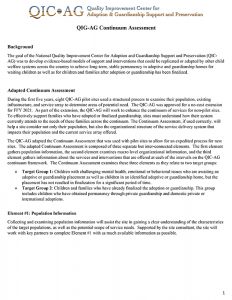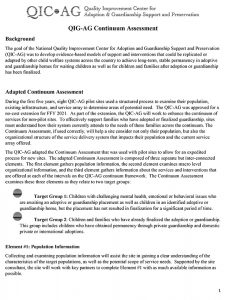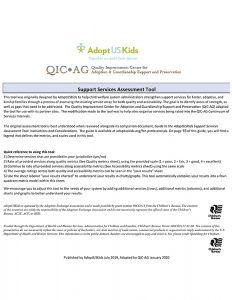Annual Lessons Learned
To better support today’s adoption and guardianship families, it is important to understand service availability as well as service delivery systems that attend to these families. The QIC-AG developed an assessment tool that can be used to help sites consider key factors when determining the need for change. Check out the webinar and materials below to learn more about this tool and how it can be used to help better understand the strengths and limitations of your system and inform transformation.
WEBINAR
On April 21, 2021 Project Director Leslie Cohen, Site Consultant Stephanie Hodge Wolfe, and North Dakota Administrator of Adoption Services and QIC-AG site champion, Julie Hoffman hosted a webinar all about the QIC-AG’s continuum assessment tool and process.
You can watch below and view the slides here
ASSESSMENT TOOLS
Here is more information about the QIC-AG Assessment Process and the tools you can use to assess your system. To learn more about the QIC-AG Assessment Process and how we adapted the AdoptUSKids Assessment tool, click here.
ASSESSING SYSTEMS TO SUPPORT ADOPTION AND GUARDIANSHIP FAMILIES
To better support today’s adoption and guardianship families, it is important to understand service availability as well as service delivery systems that attend to these families. The QIC-AG developed an assessment tool that can be used to help sites consider key factors when determining the need for change. Check out the webinar and materials below to learn more about this tool and how it can be used to help better understand the strengths and limitations of your system and inform transformation.
WEBINAR
On April 21, 2021 Project Director Leslie Cohen, Site Consultant Stephanie Hodge Wolfe, and North Dakota Administrator of Adoption Services and QIC-AG site champion, Julie Hoffman hosted a webinar all about the QIC-AG’s continuum assessment tool and process.
You can watch below and view the slides here
ASSESSMENT TOOLS
Here is more information about the QIC-AG Assessment Process and the tools you can use to assess your system. To learn more about the QIC-AG Assessment Process and how we adapted the AdoptUSKids Assessment tool, click here.
This is a recording of the webinar presented on February 12, 2020.
Description:
With the six key messages as a guide, Leslie Cohen and Stephanie Hodge Wolf highlight the practical tools, materials, and content created by QIC-AG and offer a deeper understanding of how the work can be useful for members of the child welfare community as well as allied professionals.
This is a recording of the Lessons Learned webinar presented July 31, 2019
Description:
During this webinar you will hear what we learned (sometimes the hard way), related to staffing and staff support, recruitment and retention, cost/sustainability, stakeholder collaboration, and logistics. We’ll also share concrete examples from the QIC-AG partner sites that can be applied to the implementation of any intervention.
This is a recording of the Lessons Learned webinar presented September 26th, 2018
Description:
Pediatric health providers, teachers, and social service professionals play a critical role in the lives of families who have adopted. Once an adoption has been finalized, these professionals typically have more frequent contact with adoptive families than child welfare professionals. Consequently, families look to these professionals for guidance, insight and support. In light of this, it is critical for these professionals to have familiarity with adoption. This presentation will include a panel of medical, educational and child welfare professionals who will discuss how to create a network of adoption competent providers. Specific information will be provided on how to engage pediatric health providers and teachers in a manner that helps them to become more adoption competent
This is a recording of the Lessons Learned webinar presented September 25th, 2017
Description:
The National Quality Improvement Center for Adoption/Guardianship Support and Preservation (QIC-AG) developed a Permanency Continuum Framework built on the premise that children in adoptive and guardianship families fare better when their caregivers are prepared and supported to address issues before they arise, and before issues escalate into crisis. However, the QIC-AG sites are learning that it can be challenging to engage families who are not seeking support or do not perceive that they currently have service needs. This webinar will highlight Illinois and New Jersey’s efforts to proactively involve families in services that prepare children and families for the teenage years. Presenters will discuss the integrated theory of participation and how Illinois and New Jersey developed and refined their interventions offered through the QIC-AG to mitigate these challenges. Additionally, the webinar will discuss how the lessons learned in these sites might refine future thinking about proactive service delivery for adoptive and guardianship families.
This is a recording of the webinar presented September 27th, 2016.
Duration: 1 hour 30 minutes
Click here to download the Webinar Presentation.
Meeting Description:
According to estimates by the U.S. Department of Health and Human Services, there are more than two children in IV-E funded adoptive or guardianship homes for every one child in IV-E funded foster care. The child welfare system of the 21st century requires that we redefine our systems of care to address the needs of children and families while they are in foster care, and after legal permanence has been achieved.
As knowledge of the life-long impacts of trauma on children evolves, child welfare systems are finding themselves increasingly aware of the needs of children and families, post-permanence. To meet this need, child welfare systems have to redefine their continuum of services so that programming continues, post-legal permanence. Public Law 113-183 requires states to spend a designated portion of their Title IV-E adoption assistance de-link savings on post-adoption and guardianship services. However, with limited funds and a growing number of children and families in this pool, it is critical that child welfare systems identify and implement evidence based interventions that have proven to be effective.
The National Quality Improvement Center for Adoption/Guardianship Support and Preservation (QIC-AG) is a 5-year project that aims to promote permanence for children when reunification is no longer the goal, and improve adoption and guardianship preservation and support. The QIC-AG will work with 8 sites to develop evidence-based interventions that can be replicated or adapted by child welfare systems across the country.
This webinar provided an overview of child welfare in the 21st century, highlighted research regarding discontinuity, and reviewed a continuum framework that the QIC-AG has developed which begins at entry and continues post-legal permanence. A demonstration of how this framework can be applied to a child welfare system and be used to assess the strengths and limitations of a service system was also demonstrated.




